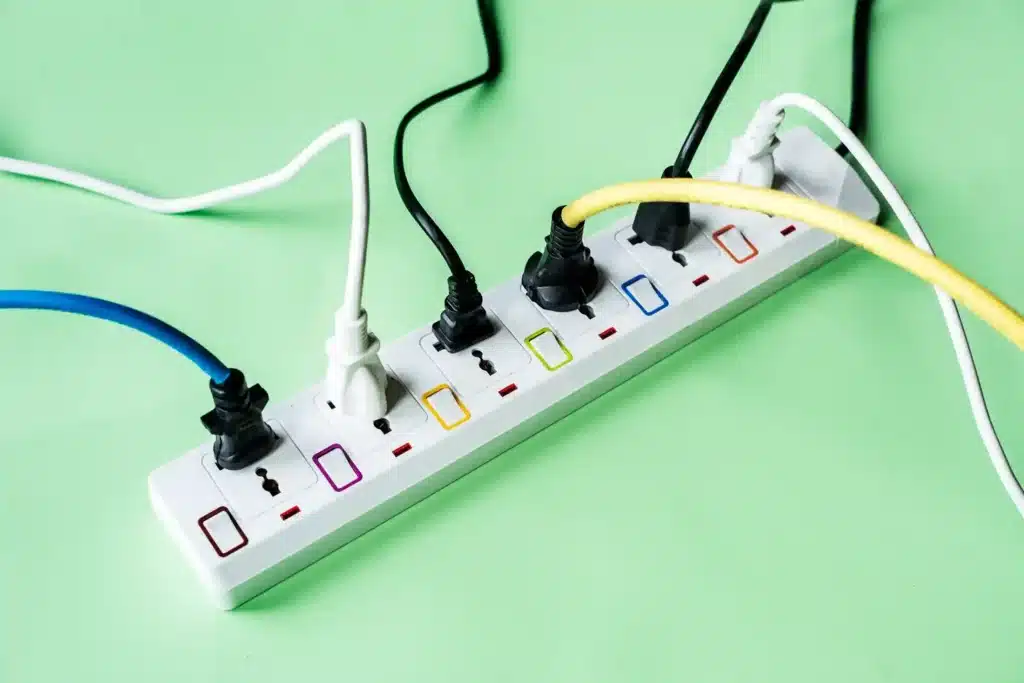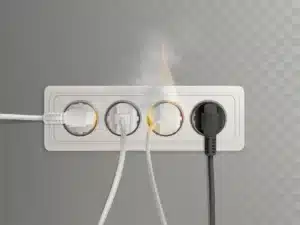Have you ever wondered, “How safe is a Multi-Plug Outlet?” With more gadgets than ever, we often rely on these convenient devices to power everything from smartphones to home appliances. But are they truly safe? Overloading, poor-quality materials, and improper use can pose serious risks like electrical fires or device damage.
In this article, we’ll break down how multi-plug outlets work, the potential hazards, and how to use them safely to protect your home and devices.
Understanding a Multi-Plug Outlet
A multi-plug outlet is a handy tool that lets you use multiple electrical gadgets at once without needing extra wall sockets. Whether in households or offices, this device helps accommodate the needs of several devices concurrently, making it a must-have for modern spaces.
I’ve relied on a power strip when I had just a single socket for all my devices. It felt like a lifesaver, but I quickly learned that not all are built the same. Some extension blocks handle high loads, while others overheat if powered beyond their limit.
Different Types of Multi-Plug Outlets
Multi-plug outlets come in different shapes and designs, each serving a unique purpose. Let’s explore the most common types and how they are used.
1. Basic Multi-Plug Adapter
This is the simplest type. It looks like a small box with multiple sockets, allowing you to plug in two or more devices at once. It’s great for low-power devices like lamps, phone chargers, and small fans.
2. Power Strips
A power strip is a long, narrow device with multiple outlets in a row. It usually comes with a switch to turn all connected devices on or off at once. Some power strips also have surge protection, which helps prevent damage from sudden voltage spikes.
3. Surge Protector
A surge protector looks similar to a power strip but has a special feature: it protects your devices from power surges. If lightning strikes or there’s an electrical overload, the surge protector absorbs the extra electricity and keeps your gadgets safe.
4. Smart Multi-Plug Outlet
This modern type connects to Wi-Fi and allows you to control your devices through a smartphone app. You can turn electronics on or off remotely, set schedules, and even use voice commands with smart home assistants like Alexa or Google Assistant.
5. USB Multi-Plug Outlet
This type includes both regular plug sockets and USB ports. It’s perfect for charging phones, tablets, and other USB-powered devices without needing an adapter.
6. Wall-Mounted Multi-Plug Outlet
This type is designed to fit directly over an existing wall socket. It provides extra outlets without needing a power strip, making it a space-saving option for small rooms.
The Potential Risks of Multi-Plug Outlets
Multi-plug outlets are useful, but they also come with risks. If not used correctly, they can cause electrical problems that might lead to accidents. Below are a few of the most frequent hazards:
1. Overloading the Outlet
Each outlet in your home is designed to handle a certain amount of electricity. When you plug in too many devices at once, the outlet can get overloaded. This can cause the wires to heat up, which may lead to sparks or even a fire.
2. Fire Hazard
Old or low-quality multi-plug outlets can wear out over time. If the plastic casing gets damaged or the internal wiring becomes loose, it can cause short circuits. This may result in overheating and increase the risk of an electrical fire.
3. Power Surges
Sometimes, a sudden increase in electricity, called a power surge, can damage plugged-in devices. If your multi-plug outlet does not have surge protection, it won’t be able to stop extra voltage from reaching your electronics, possibly ruining them.
4. Loose Connections
If a plug does not fit snugly into the multi-plug outlet, it may create a loose connection. This can cause small sparks, which over time, may burn the outlet or damage the devices connected to it.
5. Poor-Quality or Counterfeit Products
Not all multi-plug outlets are made with high-quality materials. Cheap or unbranded ones might not follow safety standards. They can easily break, overheat, or fail to protect your devices, making them dangerous to use.
6. Tripping Hazard
Power strips and extension cords attached to multi-plug outlets can create clutter, especially on the floor. If not placed properly, people may trip over them, leading to injuries or causing the wires to get yanked out suddenly.
How to Stay Safe?
To avoid these risks, always use high-quality multi-plug outlets with surge protection. Don’t overload them, and check regularly for any signs of damage. If you notice burning smells, sparks, or loose connections, stop using the outlet immediately and replace it with a safer one.

Common Mistakes People Make with Multi-Plug Outlets
Multi-plug outlets make life easier by letting us use multiple devices at once. However, many people make simple mistakes that can be dangerous. Here are a few typical mistakes:
1. Plugging in Too Many Devices
One of the biggest mistakes is overloading the outlet. Each plug draws electricity, and if you connect too many devices at once, it can cause overheating and increase the risk of a fire.
2. Using High-Powered Appliances
Multi-plug outlets are not meant for heavy-duty appliances like heaters, microwaves, or refrigerators. These devices use a lot of power and can overload the outlet, leading to short circuits or even burning the wires.
3. Ignoring Surge Protection
Not all multi-plug outlets protect against power surges. If you use a basic one without surge protection, your electronic devices could get damaged during sudden voltage spikes.
4. Daisy-Chaining (Connecting One Power Strip to Another)
Some people connect one power strip to another to get extra outlets. This is very dangerous because it can overload the circuit and cause the wires to overheat, increasing the risk of electrical fires.
5. Using Old or Damaged Outlets
Multi-plug outlets wear out over time. If you see cracks, burn marks, or loose connections, stop using them immediately. Damaged outlets can cause sparks, which might lead to an electrical fire.
6. Placing Power Strips Under Rugs or Furniture
Hiding power strips under carpets or furniture might seem like a good way to keep them out of sight, but it’s unsafe. Heat can build up, and if the wires get damaged, they could start a fire.
7. Pulling the Plug Out by the Cord
Yanking the cord out of the socket instead of pulling the plug directly can weaken the wires inside. Over time, this can lead to exposed wires, which are a serious shock and fire hazard.
How to Use Multi-Plug Outlets Safely?
- Use only as many devices as the outlet can handle.
- Check for surge protection before plugging in sensitive electronics.
- Never plug in high-power appliances like heaters or microwaves.
- Avoid connecting multiple power strips together.
- Inspect your outlets regularly and replace damaged ones.
- Keep power strips in open spaces to allow heat to escape.
By avoiding these mistakes and following safety tips, you can use multi-plug outlets safely without risking your home or devices.
Conclusion
Multi-plug outlets are a handy solution for powering multiple devices, but they must be used safely. Overloading them, plugging in high-powered appliances, or using low-quality outlets can lead to serious risks like overheating, short circuits, and even fires.
By choosing the right type, checking for surge protection, and avoiding common mistakes, you can ensure the safety of your home and electronics. If you’re unsure about your electrical setup or need professional help, Spark Edge Electric is here to assist you. Our expert team provides reliable and safe electrical solutions to keep your home and office powered efficiently.
Trust Spark Edge Electric for top-quality service and peace of mind when it comes to electrical safety.

